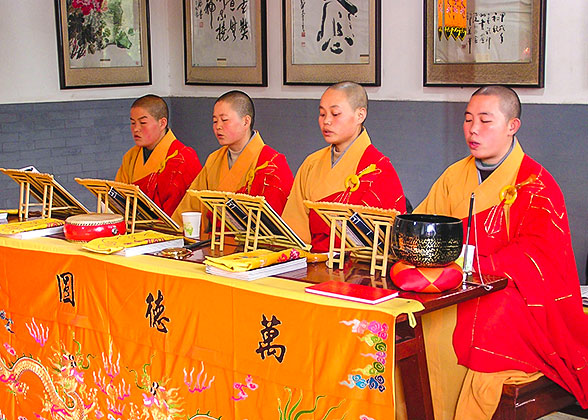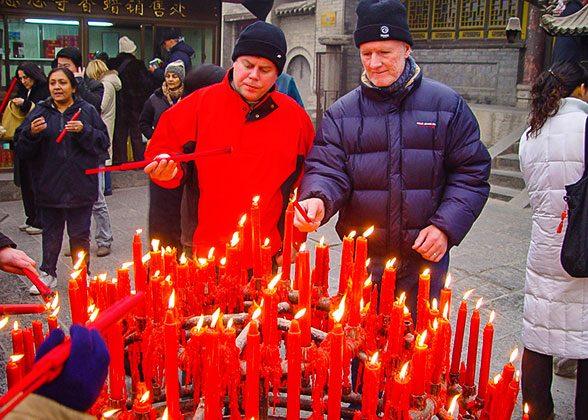Giant Wild Goose Pagoda (Dayan Pagoda)
As the symbol of the old-line Xi'an, Giant Wild Goose Pagoda (also called Big Wild Goose Pagoda) is a well-preserved ancient building and a holy place for Buddhists. It is located in the southern suburb of Xi'an City, about 4 kilometers (2.5 miles) from the downtown of the city. Standing in the Da Ci'en Temple complex, it attracts numerous visitors for its fame in the Buddhist religion and its simple but appealing style of construction. Giant Wild Goose Pagoda is rated as a National Key Cultural Relic Preserve as well as an AAAA Tourist Attraction. In addition, it was added to the World Heritage List on June 22, 2014, together with other sites along the ancient Silk Road.
This whole scenic area include the Big Wild Goose Pagoda, the Da Ci'en Temple, and the various squares, gardens and other facilities around. 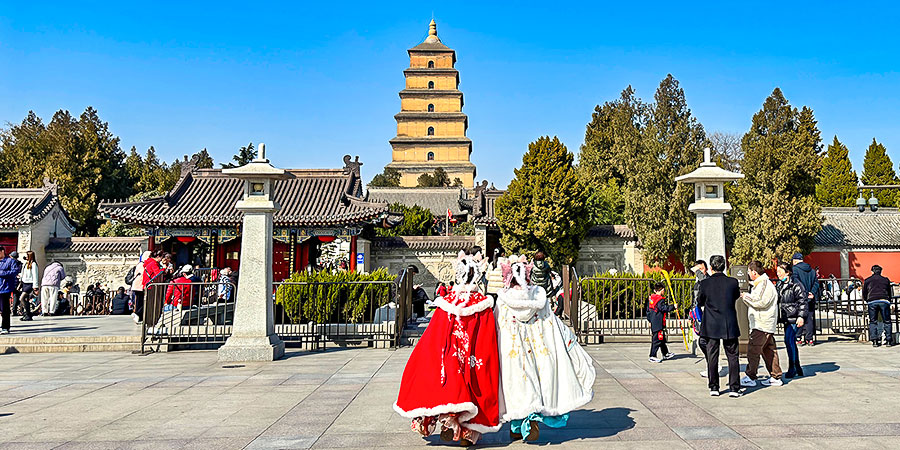
Giant Wild Goose Pagoda
Xuanzang started off from Chang'an (the ancient Xi'an), along the Silk Road and through deserts, finally arriving in India, the cradle of Buddhism. Enduring 17 years and traversing 100 countries, he obtained Buddha figures, 657 kinds of sutras, and several Buddha relics. Having gotten the permission of Emperor Gaozong (628-683), Xuanzang, as the first abbot of Da Ci'en Temple, supervised the building of a pagoda inside it. With the support of royalty, he asked 50 hierarchs into the temple to translate Sanskrit in sutras into Chinese, totaling 1,335 volumes, which heralded a new era in the history of translation. Based on the journey to India, he also wrote a book entitled 'Pilgrimage to the West' in the Tang Dynasty, to which scholars attached great importance.
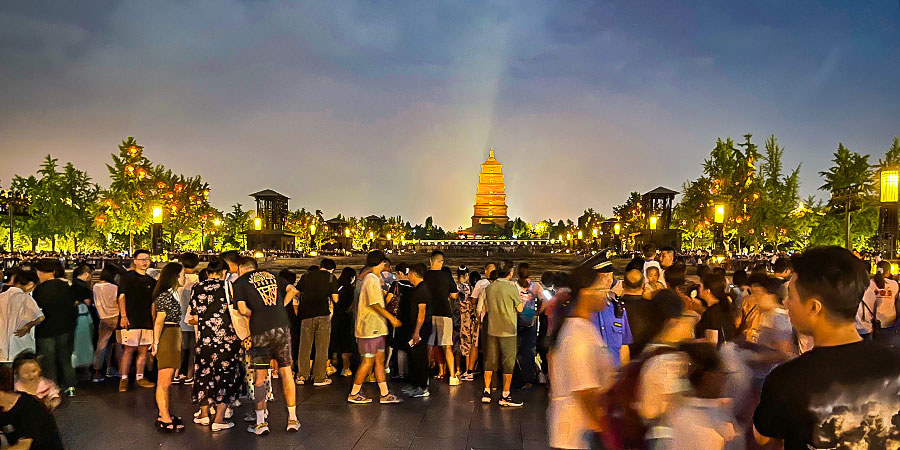 |
| Night View of Giant Wild Goose Pagoda |
First built to a height of 60 meters (197 feet) with five storeys, Giant Wild Goose Pagoda is now 64.5 meters (211.6 feet) high with an additional two storeys. It was said that after that addition came the saying-'Saving a life exceeds building a seven-storey pagoda'. Externally Big Wild Goose Pagoda looks like a square cone, simple but grand and it is a masterpiece of Buddhist construction. Built of brick, its structure is very firm. Inside the pagoda, stairs twist up so that visitors can climb and overlook the panorama of the city from the arch-shaped doors on four sides of each storey. On the walls are engraved fine statues of Buddha by the renowned artist Yan Liben of the Tang Dynasty. Steles by noted calligraphers also grace the pagoda.
As for the reason why it is called Giant Wild Goose Pagoda, there is a legend. According to ancient stories of Buddhists, there were two branches, for one of which eating meat was not a taboo. One day, they couldn't find meat to buy. Upon seeing a group of big wild geese flying by, a monk said to himself: 'Today we have no meat. I hope the merciful Bodhisattva will give us some.' At that very moment, the leading wild goose broke its wings and fell to the ground. All the monks were startled and believed that Bodhisattva showed his spirit to order them to be more pious. They established a pagoda where the wild goose fell and stopped eating meat. Hence its name.
Da Ci'en Temple is the home of Giant Wild Goose Pagoda. In 648, the temple is built to commemorate the dead virtuous queen, for which the status and scale far exceeded all others. Today, with an area of 50,738 square meters (12.5 acres), one seventh of the original area, it still retains its grandeur.
Before the temple, there stands a statue of hierarch Xuanzang, the meritorious hierarch. With guarding lions at both sides of the gate, the temple seems stately for lions were said to function as talismans. Entering the temple you will see two buildings - Bell Tower in the east and Drum Tower in the west. Along the central axis are arranged the Hall of Mahavira, Sermon Hall, Big Wild Goose Pagoda, and the Hall of Xuanzang Sanzang.
|
|
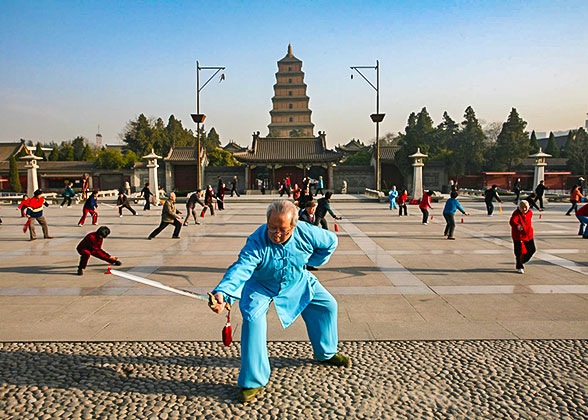 |
| Morning Exercise on South Square |
Tai Chi Sword Performance
Tai Chi Kung Fu Fan Performance
How to get to Giant Wild Goose Pagoda
Take bus no. 19, 24, 30, 34, 400, 521, 701, 44, 242, 271, 408 to North Square of Giant Wild Goose Pagoda; or take 21, 271, 408, 601, 606 or Tourist Line 6 to South Square of Giant Wild Goose Pagoda.
Take Metro Line 3 & Line 4 to Dayanta Station directly.
Take Metro Line 2 to Xiaozhai Station (Exit C) and walk eastward for 10 minutes.
Xi'an Bus / Metro Search
Ticket & Opening Hours
| Ticket Price | Entrance Fee of Da Ci'en Temple: CNY 40; free for children under 1.2m (3.9 feet) and no more than 6 years old, and the elderly over 65. Ascending the Pagoda: CNY 25 Note: Those who want to ascend the pagoda should buy the entrance ticket of Da Ci'en Temple as well. |
|---|---|
| Opening Hours | 8:30 - 17:00 |
| Admission Fee | Free |
|---|---|
| Timetable | 12:00-12:10; 16:00-16:10; 19:00-19:10; 21:00-21:10 |
How to get to the surrounding scenic spots
Take bus 5, 19, 24, 26, 27, 30, 34, 400 or Tourism Bus No. 8 (610) and get off at Cuihua Road Station.
Take bus 22, 24 from Giant Wild Goose Pagoda and get off at Tang Paradise South Gate. Or take bus 21, 601 or Tourism Bus Route 8 and get off at Tang Paradise North Gate.
Take bus 601 or Tourism Bus Route 8 and get off at Qujiang Polar Ocean Park.
Take bus 22, 609 or Qujiang Tourist Bus to Qujiangchi Yizhi Gongyuan (Qujiang Pool Park).
Take bus 22 and get off at Hanyao Road West Crossing Station.
Take bus 224 or Qujiang Tourist Bus to Qujiangchi (Qujiang Pool) and then walk east for 3 minutes there.
Just southwards Giant Wild Goose Pagoda, walk there directly.
